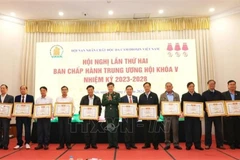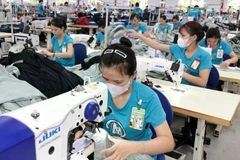 The development direction of the city across the Red River includes the entire administrative boundaries of Dong Anh, Soc Son, and Me Linh districts. (Photo: thanhnien.vn)
The development direction of the city across the Red River includes the entire administrative boundaries of Dong Anh, Soc Son, and Me Linh districts. (Photo: thanhnien.vn) Building upon the 2011 master planning scheme, Hanoi's urbandevelopment strategy divides the city into five regions. These encompass thecentral urban area, including the historic inner city and expanding zones likeDan Phuong, Hoai Duc and Thanh Tri.
The eastern urban area covers Long Bien and Gia Lam districts,while the northern region comprises Dong Anh, Me Linh, and Soc Son districts.The western area encompasses Son Tay, Ba Vi, Phuc Tho, Thach That and ChuongMy, while the southern area includes Thanh Oai, My Duc, Ung Hoa, Thuong Tin andPhu Xuyen.
Hanoi's plan introduces the 'city within the capital' model,aiming to develop new urban centres. This involves constructing a northern cityin Dong Anh, Me Linh and Soc Son districts and a western city in theHoa Lac high-tech zone (Thach That district) and Xuan Mai town (Chuong My district).
Following the establishment of the second airport in the capitalregion, Hanoi plans to develop a city in the southern area, spanning Phu Xuyenand Ung Hoa districts. This city will be integrated with the airport and serveas a comprehensive transport hub, including aviation, railways (national andurban), waterways (Red River) and highways.
The northern city of Hanoi, centred around Noi Bai Airport,will focus on industrial, service, financial and high-tech sectors.Additionally, it will promote eco-tourism and entertainment centres. By 2045,it's projected to cover around 633sq.km, with an urban land area of 385 sq.kmand a population of about 3.25 million, distributed across 45 wards and 24communes.
The western city around the Hoa Lac high-tech zone and Xuan Mai town,is envisioned as a hub for scientific research, high-tech training, and thedevelopment of advanced technology products. It will span approximately 251sq.km,with an estimated population of about 1.2 million by 2045. Urban constructionland will cover around 135sq.km, accommodating roughly 1.08 million residents,while suburban areas will encompass about 116sq.km with a population ofapproximately 120,000. This city is projected to consist of 16 wards and 8communes.
In addition, Hanoi plans to transform rural areas in the southernregion, including Thanh Oai, My Duc, Ung Hoa, and Phu Xuyen districts, intocentres for high-tech agriculture and eco-religious tourism.
For land use planning, Hanoi anticipates that urban constructionland will encompass about 90,000ha by 2030, accounting for 27% of the city'stotal area. By 2025, this figure is expected to increase to around 120,000hectares, representing 36% of the city's total area./.





























